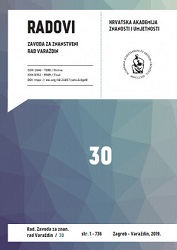POPISI VLASNIKA GRADSKIH ZEMLJIŠTA U VARAŽDINU IZ DRUGE POLOVICE 17. STOLJEĆA
PROPERTY OWNERSHIP RECORDS IN VARAŽDIN IN THE SECOND HALF OF THE 17TH CENTURY
Author(s): Višnja BurekSubject(s): Civil Society, Public Administration, Public Law, Local History / Microhistory, Social history, Demography and human biology, 17th Century
Published by: Hrvatska akademija znanosti i umjetnosti - Zavod za znanstveni rad Varaždin
Keywords: census; Varaždin; parcel; taxes; 17th century;
Summary/Abstract: The city authorities in Varaždin compiled a number of lists of estate owners with the purpose of collecting the regular and supplementary taxes as well as other levies imposed by the city government. From the second half of the 17th century nine such records have been preserved, the last of which, dating from 1698, is a complete document, while the rest refer only to certain city areas. The records also provide information on the number of parcels owned by Jesuits, Pauline Fathers, prelates, members of the Varaždin Generalate, and customs offices, which, as owners of city parcels, were also required to pay taxes. The amount of these taxes depended on the size of their parcels. The analysis of the average size of estates shows that there is a noticeable economic and social divergence in the city during the second half of the 17th century. While the inner-city inhabitants owned 1.5 – 2 plots on average, in the suburbs the average estate size was between 1.1 and 1.4 plots. The average size of estates was affected by the owners of a larger number of plots, such as monasteries, the Church, and both military and civil services of the Kingdom. The number of their plots, particularly in the inner city is increasing and at the end of the 17th century they own more than twenty percent of city lands. The biggest individual owners are Jesuits. A larger number of plots is also owned by judges, senators and noblemen. In the suburbs, there is a completely different process at work. Instead of augmentation, the estates are being divided into smaller parcels of land. This proves a higher population density in the suburban areas, which resulted in an increased number of the poor and those citizens whose economic power is in decline. Besides allowing the analysis of the economic and social processes in the city, the records are a valuable source in estimating the number of inhabitants in Varaždin at the end of the 17th century. Taking into consideration the number of uninhabited plots and the average number of household members, between 2,850 and 3,350 inhabitants are estimated to have lived in Varaždin at that time. Except for the names and plot sizes, the records also contain the information on locations, types, quality of these lands and the amount of taxes and duties paid. They are therefore an important source in investigating the history of the land register of the city of Varaždin.
Journal: Radovi Zavoda za znanstveni rad Varaždin
- Issue Year: 2020
- Issue No: 31
- Page Range: 31-74
- Page Count: 44
- Language: Croatian

